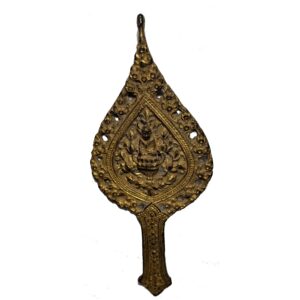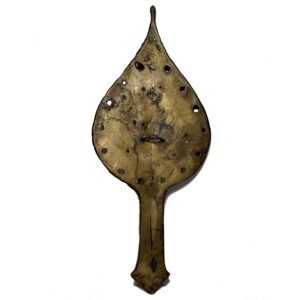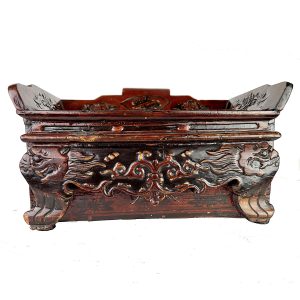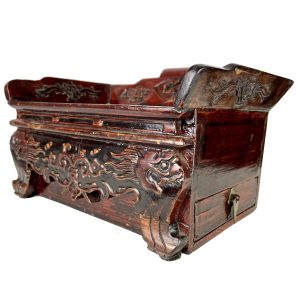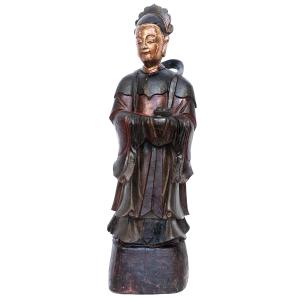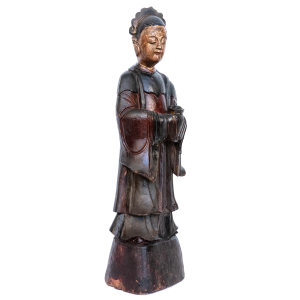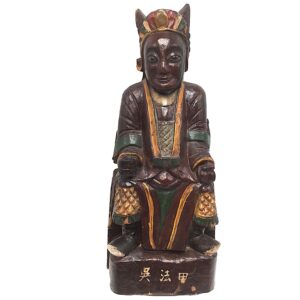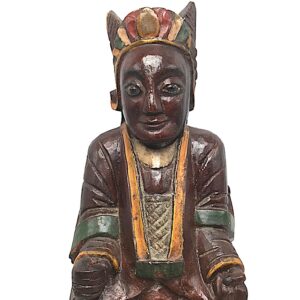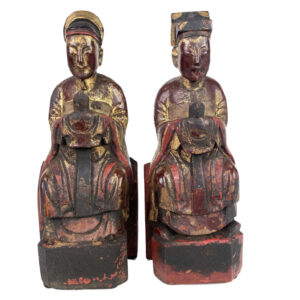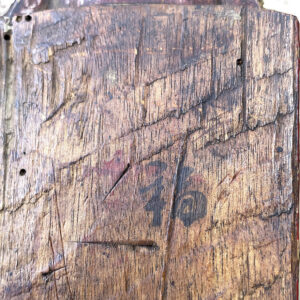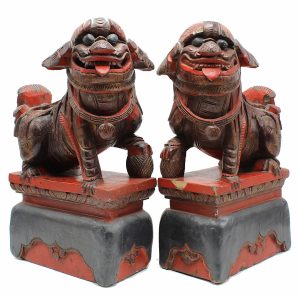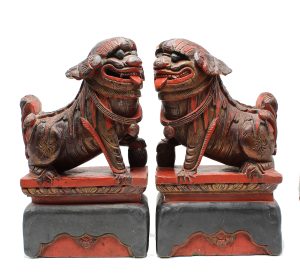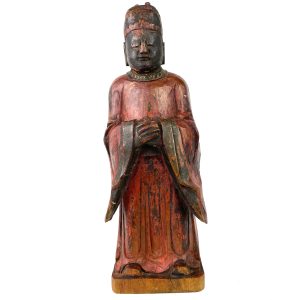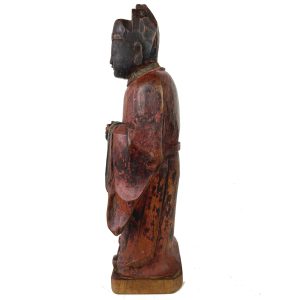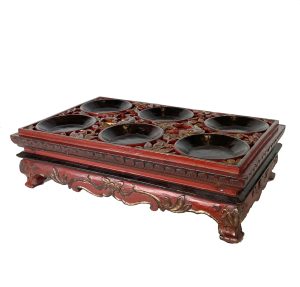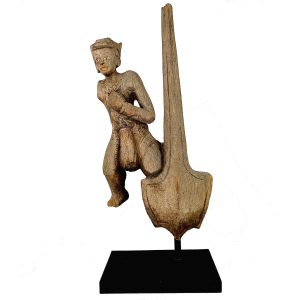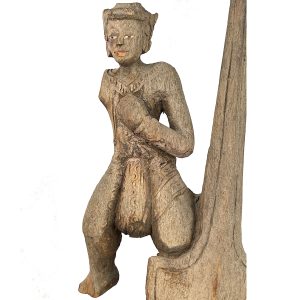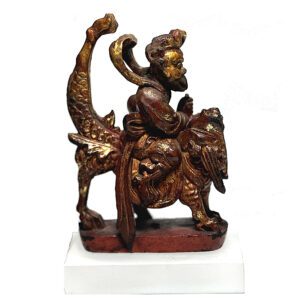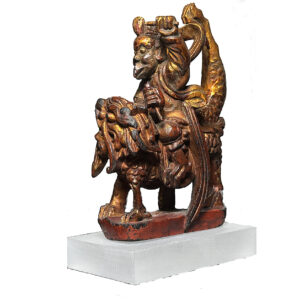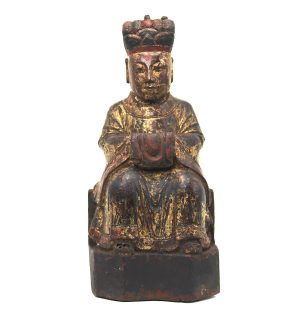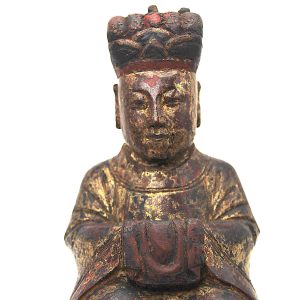Showing 37–48 of 430 results
-
Sale!


$575.00 Original price was: $575.00.$495.00Current price is: $495.00.
H: 10″ W: 4.125 | FREE SHIPPING WITHIN CONTINENTAL U.S.
Rare Thai Ratanakosian gilded bronze ceremonial fans used by monks or high-ranking individuals and displayed in temples or homes as a sacred decoration or ritual object. Shaped like a bodhi leaf with a Buddha in Earth Witnessing mudra.
-
Sale!


$325.00 Original price was: $325.00.$225.00Current price is: $225.00.
H: 6.375″ W: 10.75″ D: 7.125″ | FREE SHIPPING WITHIN CONTINENTAL U.S.
Charming carved and lacquered multi-use box, opening top and side drawer. Auspicious carved symbols – fu lion heads on front and plum blossoms and fan the front and frame. Painted calligraphic wish for sons. Likely was and still is unique wedding gift .
-
Sale!


$2,400.00 Original price was: $2,400.00.$1,950.00Current price is: $1,950.00.
H: 25″ W: 7.5″ D: 6″ | CALL 213-568-3030 OR EMAIL [email protected] FOR SHIPPING.
Graceful celestial attendant carrying offerings with ribbon winding around her with a modest and serene demeanor honoring the deity she attends.
-
Sale!


$325.00 Original price was: $325.00.$275.00Current price is: $275.00.
H: 12.75″ W: 3.375″ D: 3″ | FREE SHIPPING WITHIN CONTINENTAL U.S.
Either a Taoist house deity/dignitary or an ancestor figure, this colorful provincial carving has painted calligraphy identifying his name. The image has characteristics of Guandi, the God of War holding a tael or a military seal with military maille.
-
Sale!


$850.00 Original price was: $850.00.$650.00Current price is: $650.00.
H: 7.5″ W: 2.875″ D: 2″ | FREE SHIPPING WITHIN CONTINENTAL U.S.
VA’s most unique and finely crafted Kitchen God couple. Beautifully carved, clasping hu tablets, approachable features, smiling lips. Painted character on base wish for “happiness.” Add positive chi, enhance feng-shui.Unique house warming/wedding gifts.
-
Sale!


$995.00 Original price was: $995.00.$695.00Current price is: $695.00.
H: 12″ D: 7″ D: 7.75″ | FOR SHIPPING INFORMATION CONTACT US AT 213-568-3030
This very fine pair of antique carved males fu lions represents the dual nature of these mythical animals: as protective images they are powerful and fierce, as Buddhist images they are whimsical with smiling faces, dangling tongues, hanging ears and bushy tails. They are extremely well carved with harnesses and bells around their necks, detailed manes and tails on high intricately decorated bases to signal their importance. Perfect for enhancing feng shui in a home or office, large finely decorative wood pairs like this are extremely hard to find.
-
Sale!


$275.00 Original price was: $275.00.$225.00Current price is: $225.00.
Finely carved from dense wood Mazu is the Heavenly Empress on a horseshoe chair, holding official’s girdle, phoenix hat with outstretched wings and cloud collar symbolizing her place in heaven.
-
Sale!


$425.00 Original price was: $425.00.$250.00Current price is: $250.00.
Ht: 8.25″ W: 3″ D: 2.125″ | FREE SHIPPING IN CONTINENTAL US
Ancestor figure portrayed as a civilian official standing on a rectangular base with hands together wearing a long civil official’s robe that extends to his shoes.
-
Sale!

$475.00 Original price was: $475.00.$325.00Current price is: $325.00.
H: 5.625″ W: 27.875″ D: 9.75″ | FOR SHIPPING INFORMATION CONTACT US AT 213-568-3030 OR EMAIL [email protected]
This exceptionally crafted and beautiful footed confection mould was most probably a marriage gift from a wealthy family to the newlyweds as seen its symbolisms. It is elaborated and ornately decorated in vibrant reds and gilt with auspicious symbols for fidelity, fertility and happiness with lotuses and pods filled with seeds, bats, paired fish and intertwined vines representing a life pair, having sons, and other marriage wishes.
-
Sale!


$450.00 Original price was: $450.00.$315.00Current price is: $315.00.
H: 23″ W: 10″ D: 5.5″ | CALL 213-568-3030 OR EMAIL [email protected] FOR SHIPPING
This fanciful teak carving is a Nat placed atop a large shield wearing a sarong and eyes with inset mother of pearl. Although of shamanistic origins, they are still in Buddhist temples, pagodas, government buildings, and in nat centers throughout Burma.
-
Sale!


$345.00 Original price was: $345.00.$225.00Current price is: $225.00.
H: 6″ W: 2.5″ D: 4″ | FREE SHIPPING within continental US.
Miniature Taoist Thunder God who protects from injustice and punishes evildoers with his drum, mallet, chisel. Has bird’s beak and claws and dragon’s wings, rides a mythical hou. Part of bed frame carving with many protective deities.
-
Sale!


$350.00 Original price was: $350.00.$250.00Current price is: $250.00.
H: 9.25″ W: 4.5″ D: 3.25″ | FREE SHIPPING WITHIN CONTINENTAL U.S.
Taoist official home altar carving painted on front and back with red, gilt and lacquer. Hands under ritual cloth symbolically holding a hu tablet associated with Taoist officials. Taoist were responsible for protecting against evil in this life, Buddhist for souls in next life.
End of content
End of content

